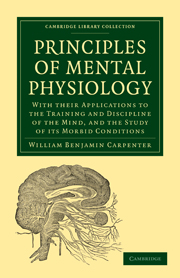 Principles of Mental Physiology
Principles of Mental Physiology Book contents
- Frontmatter
- PREFACE
- Contents
- BOOK I GENERAL PHYSIOLOGY
- CHAPTER I OF THE GENERAL RELATIONS BETWEEN MIND AND BODY
- CHAPTER II OF THE NERVOUS SYSTEM AND ITS FUNCTIONS
- CHAPTER III OF ATTENTION
- CHAPTER IV OF SENSATION
- CHAPTER V OF PERCEPTION AND INSTINCT
- CHAPTER VI OF IDEATION AND IDEO-MOTOR ACTION
- CHAPTER VII OF THE EMOTIONS
- CHAPTER VIII OF HABIT
- CHAPTER IX OF THE WILL
- BOOK II SPECIAL PHYSIOLOGY
- APPENDIX. DR. FERRIER'S EXPERIMENTAL RESEARCHES ON THE BRAIN
- INDEX
CHAPTER II - OF THE NERVOUS SYSTEM AND ITS FUNCTIONS
Published online by Cambridge University Press: 29 August 2010
- Frontmatter
- PREFACE
- Contents
- BOOK I GENERAL PHYSIOLOGY
- CHAPTER I OF THE GENERAL RELATIONS BETWEEN MIND AND BODY
- CHAPTER II OF THE NERVOUS SYSTEM AND ITS FUNCTIONS
- CHAPTER III OF ATTENTION
- CHAPTER IV OF SENSATION
- CHAPTER V OF PERCEPTION AND INSTINCT
- CHAPTER VI OF IDEATION AND IDEO-MOTOR ACTION
- CHAPTER VII OF THE EMOTIONS
- CHAPTER VIII OF HABIT
- CHAPTER IX OF THE WILL
- BOOK II SPECIAL PHYSIOLOGY
- APPENDIX. DR. FERRIER'S EXPERIMENTAL RESEARCHES ON THE BRAIN
- INDEX
Summary
29. The Body of Man, or of any one of the higher Animals, may be regarded as made up of two portions which are essentially distinct, though intimately blended as well in their structure as in their actions,—viz. (1), the Apparatus of Animal Life, and (2) the Apparatus of Vegetative or Organic Life.
30. To the Apparatus of Animal Life belongs the whole Mechanism of those actions which essentially distinguish the Animal from the Plant; namely, Sensation, the higher Psychical changes which Sensation initiates, and the Movements which are consequent upon them. And thus the Apparatus of Animal Life may be said to consist of the Nervous System, the Organs of Sense, and the Organs of Motion,—these last including the Skeleton or jointed framework (composed of bones, cartilages, and ligaments), and the Muscles which give motion to its parts. It is in virtue of the contractility possessed by the Muscles, that all the sensible movements of the higher Animals are performed: the skeletal framework being merely passive, and furnishing a system of levers by which the contractile power of the muscles may be advantageously applied; and the muscles being either directly united to the bones, or being connected with them by means of the cords termed Tendons, which simply communicate the tension or “pull” produced by the contraction of the muscles.
- Type
- Chapter
- Information
- Principles of Mental PhysiologyWith their Applications to the Training and Discipline of the Mind, and the Study of its Morbid Conditions, pp. 29 - 129Publisher: Cambridge University PressPrint publication year: 2009First published in: 1874


